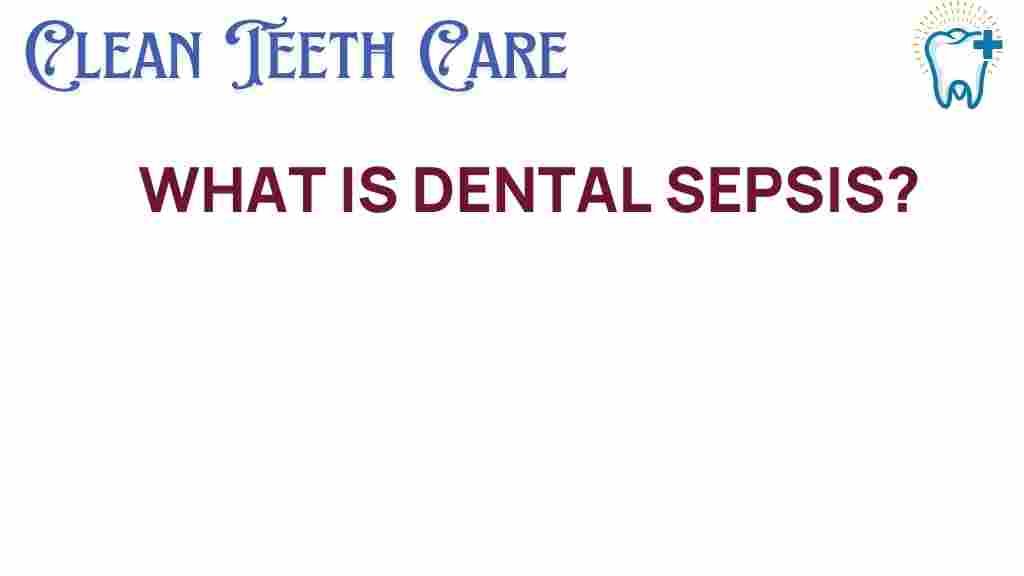Unveiling Dental Sepsis: The Hidden Threat to Oral Health
Dental sepsis is a term that may not often be discussed in everyday conversations, but it poses a significant threat to your oral health. This serious condition arises from untreated infections in the mouth, particularly stemming from gum disease or dental abscesses. As we explore dental sepsis, we will look into its symptoms, risk factors, prevention strategies, and treatment options. Understanding this hidden threat is essential for maintaining optimal oral health.
Understanding Dental Sepsis
Dental sepsis refers to a systemic infection that originates from dental issues, such as severe gum disease (periodontitis) or dental abscesses. The bacteria that cause these infections can enter the bloodstream, leading to a range of health complications. Recognizing the symptoms early on can be crucial in preventing severe consequences.
What Causes Dental Sepsis?
The primary causes of dental sepsis include:
- Untreated Gum Disease: Advanced gum disease can create pockets of infection that may spread.
- Dental Abscesses: These localized infections can occur at the root of a tooth or in the gums.
- Oral Injuries: Injuries to the mouth can introduce bacteria into the bloodstream.
- Compromised Immune System: Individuals with weakened immune systems are more susceptible to infections.
The Connection Between Gum Disease and Dental Sepsis
Gum disease is often a precursor to dental sepsis. When plaque and tartar build up, they can lead to inflammation of the gums, causing gingivitis. If left untreated, gingivitis can progress to periodontitis, where the infection spreads deeper into the supporting structures of the teeth. This progression can result in dental sepsis if bacteria enter the bloodstream.
Symptoms of Dental Sepsis
Identifying the symptoms of dental sepsis is vital for early intervention. Common symptoms include:
- Severe Toothache: Intense pain may indicate an underlying infection.
- Swelling: Swelling in the gums, face, or jaw can signify an infection.
- Fever: A high fever may indicate that the body is fighting an infection.
- Bad Breath: Persistent bad breath can be a sign of oral infection.
- Difficulty Swallowing: Inflammation can make swallowing painful.
- Fatigue: A general feeling of tiredness can accompany infections.
Risk Factors for Dental Sepsis
Understanding the risk factors associated with dental sepsis can help in its prevention. Key risk factors include:
- Poor Oral Hygiene: Neglecting dental care can lead to gum disease and infections.
- Smoking: Tobacco use significantly increases the risk of gum disease.
- Diabetes: Individuals with diabetes are more prone to infections.
- Cardiovascular Disease: Existing heart conditions can increase the risk of complications from dental infections.
- Weakened Immune System: Conditions or medications that suppress the immune system can elevate risk.
Preventing Dental Sepsis
Prevention is key when it comes to avoiding dental sepsis. Here are effective strategies to maintain oral health:
- Regular Dental Check-ups: Schedule visits to your dentist at least twice a year for check-ups and cleanings.
- Good Oral Hygiene: Brush twice a day with fluoride toothpaste and floss daily to remove plaque.
- Healthy Diet: Eat a balanced diet rich in vitamins and minerals to support oral health.
- Avoid Tobacco: Quitting smoking can significantly reduce the risk of gum disease.
- Manage Medical Conditions: Keep chronic conditions like diabetes under control to lower infection risk.
Treatments for Dental Sepsis
If dental sepsis occurs, prompt treatment is essential. Here are the common treatment options:
1. Antibiotics
Antibiotics are often the first line of defense in treating dental sepsis. They help eliminate the bacteria causing the infection.
2. Drainage of Abscesses
In cases where there is a dental abscess, a dentist may need to drain the pus to relieve pressure and promote healing.
3. Root Canal Treatment
If the infection is deep within a tooth, a root canal may be necessary to remove infected tissue and seal the tooth.
4. Surgical Intervention
In severe cases, surgical intervention may be required to remove infected tissue or teeth.
5. Follow-up Care
After initial treatment, follow-up care is vital to ensure the infection has cleared and to prevent recurrence.
Troubleshooting Common Issues
Even with proper care, some individuals may experience complications. Here are some troubleshooting tips:
- Persistent Symptoms: If symptoms like pain or swelling persist after treatment, consult your dentist immediately.
- Medication Side Effects: If you experience side effects from antibiotics, discuss alternatives with your healthcare provider.
- Oral Hygiene Issues: If you struggle with maintaining oral hygiene, consider consulting a dental hygienist for personalized advice.
The Importance of Dental Care
Regular dental care is crucial in preventing dental sepsis and maintaining oral health. This includes not only routine visits to the dentist but also being proactive about any changes in your oral health.
For more detailed information regarding oral health and the prevention of dental issues, visit the American Dental Association.
Conclusion
Dental sepsis is a serious condition that can arise from common dental issues such as gum disease and dental abscesses. By understanding its symptoms, risk factors, and prevention strategies, you can take proactive steps to safeguard your oral health. Regular dental care, good oral hygiene practices, and prompt attention to any concerning symptoms are vital in preventing this hidden threat. Remember, your oral health is a crucial part of your overall well-being.
Stay informed, stay proactive, and prioritize your dental care to avoid the ramifications of dental sepsis.
This article is in the category Conditions and created by CleanTeethCare Team
